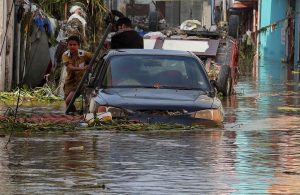The southern Indian city of Hyderabad is reeling under its worst floods in over a century. Since the second week of October it has been lashed by heavy and incessant rain, which has put vast swathes of the city under water.
Rainfall has been unprecedented. On October 13, Hyderabad is estimated to have received around 192 millimeters of rain, with some areas in the city like Himayat Nagar and Charminar receiving 298.8 mm and 245 mm respectively that day. The amount of rain the city received over a 24-hour period on October 13 exceeded what it typically receives over a month in October.
Extreme weather events like the Hyderabad rains are evident across India and growing in frequency. On July 2, Mumbai witnessed the second heaviest rainfall in a single day over the past 44 years, the highest being July 26, 2005 when the city received 944 mm in 24 hours. In 2015, Chennai received 490 mm of rain in 24 hours, the highest in a century.
Even such copious rainfall wouldn’t have led to the kind of flooding that India’s cities are witnessing had their drainage systems been functioning. Sadly, natural and man-made drainage systems that would have helped drain off excess water have been undermined over the decades and particularly so in recent years. Unplanned urban development, encroachment of lakes, and construction of buildings on reclaimed water bodies are preventing the natural run-off of water.
A 400-year-old city, Hyderabad sits on the banks of the Musi River. Hundreds of small man-made lakes, all linking up with the Musi and its tributaries, were constructed over the centuries and following the floods of 1908, two large artificial lakes, Osman Sagar and Himayat Sagar, were added to the intricate network constructed to regulate the flow of water into the Musi.
Over the past century, Hyderabad has grown enormously. Unchecked encroachment of lakes and building construction on reclaimed land and river embankments have eaten into waterways, causing them to overflow during downpours. Low-lying areas and reclaimed land go under water quickly.
Hyderabad is located in an arid region. As activist Lubna Sarawath has observed “rains should have been a blessing, but now they’re a nightmare.”
Whether it is Hyderabad, Bangalore, Chennai, or Mumbai, waterways and canals that would have drained off water have vanished and in their place shopping malls, apartment complexes, and even airports have come up. Chennai international airport’s runways are built over the usually dry Adyar River. When water in the Chembarambakkam reservoir was released during the downpour in December 2015, it rushed through its natural waterway to the sea – the Adyar. But with the river blocked, the water flooded Chennai’s tarmac and soon the airport was engulfed in water.
In the name of infrastructure development, Mumbai’s mangrove forests, which are its natural defenses against floods, are being cleared to make way for high-rise buildings and freight corridors. But mangroves absorb excess water and the building constructions are blocking rainwater from flowing freely to the sea. This is among the main reasons for the annual flooding that Mumbai experiences.
Aggravating the problem of flooding are old urban drainage systems. Mumbai’s is over a century old. According to a report by the Comptroller and Auditor General of India, Mumbai’s drains “are heavily silted and punctured at many places.” They have the capacity to take on 25 mm of rainfall per hour but during the monsoon, rainfall often exceeds 50 mm per hour.
Civic authorities do not prioritize improving the capacity of these drains. Meanwhile poor waste management and sewage systems are adding to the pressure. Dumping of construction debris in drains is rampant, causing the clogging of stormwater drains and sewage pipes. It results in sewage pipes throwing up fecal and other waste onto roads and into homes.
Consequently, urban flooding is usually followed by a spurt in cases of cholera and gastroenteritis. India is already struggling under the pressure of the COVID-19 pandemic. Flood-related epidemics loom too.

































